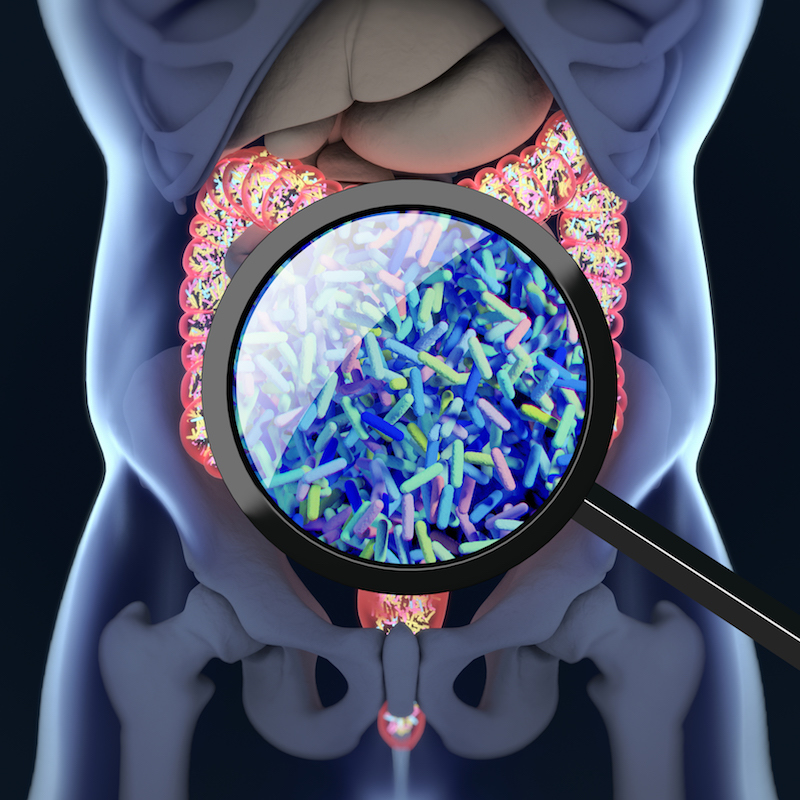Microbiome and Nutrition
The complex community of bacteria, yeasts and viruses living in our intestines, collectively known as the gut microbiome, is shaped, in part, by what we eat. Genetics, environment, and other factors also influence an individual’s microbial community. Research at the NRI investigates these complex relationships and their impact on disease risk. We use animal models and bioinformatics to study the associations between nutritional metabolites, gut microbiome, and health. What happens in the gut doesn’t stay in the gut. Your microbiome can play a role in cardiovascular disease, obesity and diabetes, and even cancer. Our team envisions a future where analysis of your microbiome can determine disease risk, and medical foods can be prescribed to treat and prevent disease by regulating the microbiome.
Publications
Microbiome and Nutrition Publications
2020
Population studies of TMAO and its precursors may help elucidate mechanisms. Meyer K
2019
Association of dietary patterns with the gut microbiota in older, community-dwelling men. Meyer K
2018
Meta-analysis of human genome-microbiome association studies: the MiBioGen consortium initiative. Meyer K
Human microbiota, blood group antigens, and disease. Sumner S
2017
Trimethylamine N-Oxide, the Microbiome, and Heart and Kidney Disease. Zeisel S
2016
Diet and Gut Microbial Function in Metabolic and Cardiovascular Disease Risk. Meyer K
Antibiotic-mediated gut microbiome perturbation accelerates development of type 1 diabetes in mice. Sumner S
Related News
Genome-wide association analysis confirms and extends the association of SLC2A9 with serum uric acid levels to Mexican Americans
Genome-wide association analysis confirms and extends the association of SLC2A9 with serum uric acid levels to Mexican Americans.
Voruganti VS, Kent JW Jr, Debnath S, Cole SA, Haack K, Göring HH, Carless MA, Curran JE, Johnson MP, Almasy L, Dyer TD, Maccluer JW, Moses EK, Abboud HE, Mahaney MC, Blangero J, Comuzzie AG.
Front Genet. 2013 Dec 16;4:279. doi: 10.3389/fgene.2013.00279. eCollection 2013.
PMID: 24379826 [PubMed]
Successful β cells islet regeneration in streptozotocin-induced diabetic baboons using ultrasound-targeted microbubble gene therapy with cyclinD2/CDK4/GLP1
Successful β cells islet regeneration in streptozotocin-induced diabetic baboons using ultrasound-targeted microbubble gene therapy with cyclinD2/CDK4/GLP1.
Chen S, Bastarrachea RA, Roberts BJ, Voruganti VS, Frost PA, Nava-Gonzalez EJ, Arriaga-Cazares HE, Chen J, Huang P, DeFronzo RA, Comuzzie AG, Grayburn PA.
Cell Cycle. 2014 Apr 1;13(7):1145-51. doi: 10.4161/cc.27997. Epub 2014 Feb 10.
PMID: 24553120
Multiancestral analysis of inflammation-related genetic variants and C-reactive protein in the population architecture using genomics and epidemiology study
Multiancestral analysis of inflammation-related genetic variants and C-reactive protein in the population architecture using genomics and epidemiology study.
Kocarnik JM, Pendergrass SA, Carty CL, Pankow JS, Schumacher FR, Cheng I, Durda P, Ambite JL, Deelman E, Cook NR, Liu S, Wactawski-Wende J, Hutter C, Brown-Gentry K, Wilson S, Best LG, Pankratz N, Hong CP, Cole SA, Voruganti VS, Bůžkova P, Jorgensen NW, Jenny NS, Wilkens LR, Haiman CA, Kolonel LN, Lacroix A, North K, Jackson R, Le Marchand L, Hindorff LA, Crawford DC, Gross M, Peters U.
Circ Cardiovasc Genet. 2014 Apr;7(2):178-88. doi: 10.1161/CIRCGENETICS.113.000173. Epub 2014 Mar 12.
PMID: 24622110
Utility of large consanguineous family-based model for investigating the genetics of type 2 diabetes mellitus
Utility of large consanguineous family-based model for investigating the genetics of type 2 diabetes mellitus.
Al-Sinani S, Hassan MO, Zadjali F, Al-Yahyaee S, Albarwani S, Rizvi S, Jaju D, Comuzzie A, Voruganti VS, Bayoumi R.
Gene. 2014 Sep 10;548(1):22-8. doi: 10.1016/j.gene.2014.06.053. Epub 2014 Jun 30.
PMID: 24993573
Early endothelial damage detected by circulating particles in baboons fed a diet high in simple arbohydrates in conjunction with saturated or unsaturated fat
Early endothelial damage detected by circulating particles in baboons fed a diet high in simple arbohydrates in conjunction with saturated or unsaturated fat.
Shi Q, Hodara V, Meng Q, Voruganti VS, Rice K, Michalek JE, Comuzzie AG, VandeBerg JL.
Am J Cardiovasc Dis. 2014 Oct 11;4(3):123-32. eCollection 2014.
PMID: 25360390 [PubMed]
November 2014
Fetal Alcohol Spectrum Disorders More Prevalent Than Expected The following, reprinted from HealthDay in an article by Tara Haelle, reveals the findings of a study conducted by NRI Researcher Professor Philip May, Ph.D. Although drinking during pregnancy has long been...

